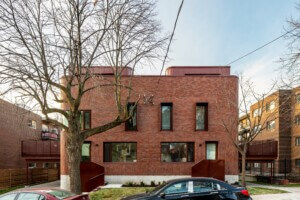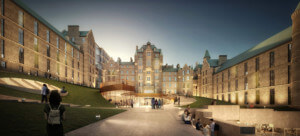MammaFotogramma designed a plywood and high-performance mesh composite that is scored on a CNC mill to facilitate textile-like movement.
WoodSkin is a flexible wood surfacing material developed by interdisciplinary design studio MammaFotogramma. The concept is an exploration of movement developed for Autoprogettazione 2.0, an open-source design competition from 2012 that originated in the firm’s work in stop motion animation. “We’re still in animation production, but what we do is all about movement,” said studio founder Giulio Masotti. MammaFotogramma’s current work includes architecture and design projects as well as a lab that evolved naturally as projects came in, where collaborators develop new techniques for hybridized exploration. “Project after project, we saw we were applying movement everywhere, not because it was a need but because it’s how we work and what we explore,” said Masotti.
Later in 2012, after the competition, the composite wood material was first fabricated as an interior finish for the lobby of Allez Up, an indoor rock-climbing facility in Montreal. “When we figured out what we wanted to do, we knew we needed something different,” said Masotti. “We needed a system, not just a project solution.” The goal was to design a visually appealing material that could be used in a static way with the possibility for movement.
- Fabricators MammaFotogramma
- Designers MammaFotogramma
- Location Montreal
- Date of Completion 2013
- Material plywood, nylon, polymer composite, custom adhesive
- Process CNC mill
To realize this, the studio devised a flexible wood composite by sandwiching Russian plywood sheets around a high-performance nylon and a polymer composite mesh, joined by a custom mix of adhesives. The mesh acts to free the plywood from its flat state and facilitate movement. The three-part compression process also strengthens the adhesive bonds and supports the skin’s movements. For the Allez Up lobby desk, 15,000 triangular tiles were scored into the composite’s surface via CNC mill to form a boulder-like organic shape.
What began as an “analog process” of sketching and handcrafting has been adapted for parametric tools because of software’s capabilities to adapt to changes throughout the design development process. Though the design capabilities are quite extensive, fabrication methods can still be quite expensive. “The processes of computer aided design can bring you far, but when it comes time to build, the technology is behind and the process becomes complicated and expensive.” To start bridging this gap, MammaFotogramma is developing a custom plugin for Rhino, with the hope that the process of fabricating WoodSkin could be replicated in multiple materials.
“The skin is made of wood but the process allowed us to collaborate with other companies that can apply their solid materials,” said Masotti. “These kinds of skins will hopefully be applied to existing materials for different finishes, such as fire and water proofing.”
WoodSkin prototypes were exhibited at Fuorisalone in Milan. A recent collaboration with Italian fabricator Biffi Carpentry has opened the WoodSkin process to the possibility of more commercial projects, as well as innovative indoor/outdoor structures like cover systems or flexible walls. “You can transform the shape you have in the skin and you can dictate the quality, thickness, and pattern for something totally unique,” said Masotti.










